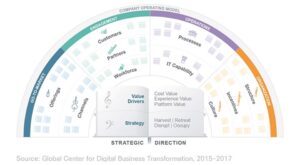At a recent Discovery Event, 55 participants from 32 companies learned about addressing the digital transformation execution challenge and balancing the need to drive value from their core business while exploring new digitally-enabled opportunities. They were also introduced to (and practiced using) a new execution framework.
Executives are mostly aware that disruption is going to hit hard in one way or another and that they need to do something. Indeed, most participants at this event were working for organizations that were themselves going through a digital business transformation (DBT). Organizations threatened by so-called value vampires sucking up an ever-increasing share of the revenues need to respond rapidly to threats and opportunities. Yet, less than one-third of them are responding effectively because they do not know what to do or how, and when they do respond, legacy systems and rigid cultures often impede their efforts.
What DBT really means and why companies should embark on it… or not
Many organizations are still confused as to what DBT really means. IMD’s Global Center for Digital Business Transformation defines it as “organizational change through the use of digital technologies and business models to improve performance.” In other words, what’s important is not the digital technologies themselves. The real focus is on transforming the business; technology only serves to support the new business model.
Considering the complexity involved in DBT, before even considering such a journey, companies should clearly define why they need to transform, what they need to transform and how to execute the transformation.
For some companies, successfully implementing DBT is a matter of survival. Those are the ones in industries that are closest to the center of what we call the Digital Vortex. Companies with a core product that can be digitized are in the middle of the vortex and at the highest risk of digital disruption. That does not mean industries on the edge of the vortex can afford to be complacent; disruption can come from any direction.
Other companies do not really need to transform and should thus not aim to because it’s expensive, difficult to manage and can disrupt the company unnecessarily. Instead, those companies should just keep doing what they do, but better and cheaper.
Disruption, blurring industry boundaries and value vampires
Disruptive companies are blurring industry boundaries. Take Amazon – in what industry would you place it? It started as an online retail company, then developed its own brands, moved into consumer goods, and expanded into web services, media and entertainment. Amazon CEO Jeff Bezos once remarked, “Your margin is my opportunity.”
Disruption is about the combination of technology and business model innovation. Digital disruptors create value in three fundamental ways:
- Cost value (by offering the same product or services cheaper or even free)
- Experience value (by focusing on customer satisfaction)
- Platform value (where customers gain more value from the wider network).
Many disruptive companies focus on one or two types of value creation, and they sometimes forget that when they switch from free to paid services, they risk losing customers and killing the business. Companies like Amazon that combine all three values are called “value vampires.” Another value vampire is Airbnb, which, compared to hotels, offers more spacious accommodation for a lower cost, a large network/offering, a more pleasant experience (friendly, homely accommodation).
Many disruptive companies focus on one or two types of value creation, and they sometimes forget that when they switch from free to paid services, they risk losing customers and killing the business. Companies like Amazon that combine all three values are called “value vampires.” Another value vampire is Airbnb, which, compared to hotels, offers more spacious accommodation for a lower cost, a large network/offering, a more pleasant experience (friendly, homely accommodation).
| Defensive | Offensive |
| Retreat
By either divesting or becoming a niche |
Occupy
By winning the space of the disruptors |
| Harvest
By blocking disruptive threats or learning from them |
Disrupt
By disrupting your own core business or creating new markets |
Figure 1: Types of strategies to fend off value vampires
The automotive industry illustrates how disruption in one industry can impact many others. On May 24, 2018, Apple and VW agreed to co-develop autonomous cars. Yet, self-driving cars are generating a lot of uncertainty about how the world will evolve because they will change some fundamental aspects of society. For example, perhaps car insurance will be on a per-trip rather than on an annual basis; it is unclear who will be responsible in case of an accident; we may see TV screens rather than radios in cars; alcohol consumption may increase if people are no longer limited by drink-driving laws; car utilization rates may go up, but the number of cars on the road may go down, which could reduce pollution and congestion but may also cause a slump in car sales, etc.
- DBT in the luxury sector
Not many luxury companies have adapted to the modern experience era: They have a supply mindset (production age), make decisions with a focus on demand (distribution age) and live the consequences in the age of experience (customer age), with incentives that were crafted for the production age. They also mostly continue to benchmark themselves against their own industry instead of looking out for emerging competitors outside.
Group chief transformation officer of Richemont Group, Frank Vivier, argued that luxury is one of the last industries to be hit by the digital tsunami, but the change is happening much faster than companies can react. He offered some words of advice based on his experience in leading digital business transformation:
- If your company was highly successful in the past and is now hit by disruption and uncertainty, start thinking differently and do things you have never done before.
- Change the culture by empowering people to figure out solutions and make decisions without having to ask for approval (ask them “what would you do if your boss died?”).
- Think digitization, not digital; rethink your own business model and processes as well as the businesses of your partners and clients, and focus on mobile.
- Look outside your own industry; customers’ expectations are defined by what is happening everywhere (e.g. they view Amazon delivery as a benchmark).
- Impose the rule of reducing the time to payback of projects by 50%, not so much to cut costs, rather to force people to ask uncomfortable and sometimes radical questions.
- Adjust your incentive system to your new business model via KPIs and customer surveys.
- Break up the general business transformation project into 5-6 smaller ones, assign ownership to individual top executives, and link their incentives to the projects individually and collectively.
- Give your best managers opportunities but based on two conditions: Success will earn them big rewards, failure will get them fired. In such harsh circumstances, people start behaving like entrepreneurs – thinking and acting fast, sometimes bending the rules, learning how to influence without authority and being prepared for uncertainty.
- Insist that the results of any initiatives must be visible within a year.
- Read the book “Antifragility” by Nassim Nicholas Taleb. It could be called the bible of insurgency.
Agile ways of working
Being able to adapt quickly to disruption requires agility. Yet most companies are not optimized to be agile; instead they are structured to execute plans in line with a traditional strategy approach – defining where you are, where you want to be and how to get there. Technology is changing faster and faster, whereas most legacy organizations are slow to adapt. This gap can be a threat, but it can also offer opportunities. On the one hand, traditional companies have the advantage of deep industry knowledge, access to capital, well-established brands and experienced people. On the other hand, transforming can be much harder for them, especially for the larger ones.
There are three main pillars to business agility: hyperawareness, informed decision-making and fast execution. Note that none of these require technology. Rather they are founding skills to survive – and thrive – in the Digital Vortex. In terms of organization, it boils down to aligning constant monitoring of the environment, strategic agility in terms of clearly set direction rather than roadmaps, and organizational agility.
Around half of the participants at the Discovery Event claimed that their companies incorporate some degree of agility, but they also felt that the process of doing so was often unclear and that it increased risk and uncertainty regarding outcomes, raised fears of losing power and depended heavily on timing. They also felt it complicated communication and the coordination of agile and non-agile parts of the organization as well as between senior-age top management and younger mid-level managers and employees. All agreed that there was no single recipe for making companies agile.
Participants concluded that strategic agility requires adaptability, flexibility, quick reactions, scenario planning, shorter review cycles, smaller – and many – bets, direction rather than goals, avoiding closing too many doors, and reconciliation. They also determined that organizational agility requires networks rather than power and control, more touch points with markets, breaking down silos, an entrepreneurial culture where everyone is a leader, diversity, a culture of trial and fail, organizing with and around customers, challenging existing rules and routines, and differentiating between generalists and specialists.
Executing your digital transformation journey
Some companies are embarking on all kinds of digitization projects because they feel like they are doing something and see themselves as cutting edge. Yet, the core of their organization remains unchanged, so they remain vulnerable to disruption. They are confusing achievements with the process and wasting money on many inefficient scattered projects
Most executives admit that their DBT fails at the execution stage. There are many reasons behind these failures, but the most important one is culture. Legacy employees, structures and processes may have brought the company to where it is now but are not necessarily adapted to take it forward. Generational and cultural differences can further complicate things. Middle managers face the greatest pressure because they are expected to execute the transformation in an environment where the culture, system of incentives and the resources remain unchanged.
IMD’s DBT center has developed a framework – the Digital Orchestra – that helps companies adopt a holistic approach to DBT (see Figure 2).
Figure 2: The Digital Orchestra framework
According to this framework, to successfully execute a DBT you need to consider and orchestrate 10 questions across the following four areas of your business:
- Going to market: What product or service do you offer? Is it the right one? How do you reach your customer?
- How you engage with key stakeholders: Customers, partners, employees
- Operations: What are your processes and IT infrastructure and capabilities?
- In terms of organization: how are you organized? How do you incentivize? What is your culture?
This is a practical tool for assessing the current situation in your company and the required degree of change in each of the four areas. Yet you must always start from the core – values and strategy. Specifically, you have to clearly define what types of value you are creating now, what the threats and opportunities are, and what value vampires are offering in your industry. Then you must choose your strategic approach: Will you deploy offensive or defensive strategies or a combination of all four? And remember that you must be agile – you will need to constantly readjust and prioritize while keeping in mind that balancing and scaling are quite difficult.
Examples of successful execution of digital business transformation
A key learning for Nespresso from its DBT was that it is less about IT projects and all about customers – their journey and experiences. Customers do not care about the channel, they want a consistent experience offline and online, so Nespresso had to deliver a personalized experience (offers, promotions, overall content) regardless of the touch point. It made drastic changes across the value chain, including to incentives, to eliminate channel rivalry, carefully balancing long-term transformation and the delivery of short-term objectives (sales and customer satisfaction), agility and scalability, local customer preferences and global perspective, digitally savvy “barbarians” who were leading the company into the future and “corporate” managers who brought the company to where it is. Learn more.
FujiFilm’s future was at stake when its core industry was digitally disrupted. It fought back by transforming itself, combining investments in digital technologies with radical organizational change. It cut its workforce, sold underperforming assets, and shifted investment into new areas such as high-end imaging machines, coatings for LCD displays, and cosmetics. The company combined existing strengths with new digital capabilities to build a brand-new organization able to compete in new markets. Today, the company is worth more than it was at its height in 2000. Learn more.
Key takeaways
Before starting out on a DBT journey, companies must be clear about why they want to transform, what they need to transform and how they are going to do it. This means asking the right questions from the outset:
- Regarding goal setting: Ask “How can we use digital to increase performance?” not “How to become digital?”
- Regarding strategy: Ask “How can digital help our strategy become agile?” not “How to build a digital strategy alongside the company’s general strategy?”
Regarding execution: Ask “How can we digitize across the whole organization and value chain?” not “How can we digitize a particular function/product/area?”
Discovery Events are exclusively available to members of IMD’s Corporate Learning Network. To find out more, go to www.imd.org/cln






